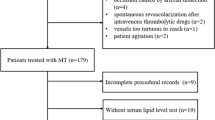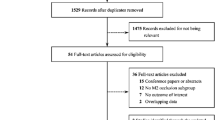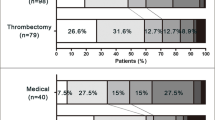Abstract
Background
An obesity paradox, whereby patients with higher body mass index (BMI) experience improved outcomes, has been described for ischemic stroke. It is unclear whether this applies to patients undergoing mechanical thrombectomy (MT) for large vessel occlusion (LVO).
Methods
Mechanical thrombectomies for anterior circulation LVO between 2015 and 2021 at a single institution were reviewed. Multivariable logistic regressions were used to determine the association between BMI and favorable functional outcome (90-day modified Rankin Scale 0–2), intracranial hemorrhage, and malignant middle cerebral infarction. A systematic review was performed to identify studies reporting the effect of BMI on outcomes among patients receiving MT for LVO. The data from the systematic review were combined with the institutional data by using a random effects model.
Results
The institutional cohort comprised 390 patients with a median BMI of 27 kg/m2. Most patients were obese [36.7% (BMI ≥ 30 kg/m2)], followed by overweight [30.5% (BMI ≥ 25 and < 30 kg/m2)], normal [27.9% (BMI ≥ 18.5 and < 25 kg/m2)], and underweight [4.9% (BMI < 18.5 kg/m2)]. As a continuous variable, BMI was not associated with any of the outcomes. When analyzing BMI ordinally, obesity was associated with lower odds of favorable 90-day modified Rankin Scale (odds ratio 0.42, 95% confidence interval 0.20–0.86). The systematic review identified three eligible studies comprising 1,348 patients for a total of 1,738 patients. In the random effects model, there was no association between obesity and favorable outcome (odds ratio 0.89, 95% confidence interval 0.63–1.24).
Conclusions
Obesity is not associated with favorable outcomes in patients undergoing MT for LVO.





Similar content being viewed by others
References
Goyal M, Menon BK, van Zwam WH, et al. Endovascular thrombectomy after large-vessel ischaemic stroke: a meta-analysis of individual patient data from five randomised trials. Lancet. 2016;387:1723–31.
Ganna I, Anna S. Obesity paradox and cardiovascular diseases. Curr Cardiol Rev. 2022.
Zhang P, Yan XL, Qu Y, Guo ZN, Yang Y. Association between abnormal body weight and stroke outcome: a meta-analysis and systematic review. Eur J Neurol. 2021;28:2552–64.
Pirson FAV, Hinsenveld WH, Staals J, et al. The effect of body mass index on outcome after endovascular treatment in acute ischemic stroke patients: a post hoc analysis of the MR CLEAN Trial. Cerebrovasc Dis. 2019;48:200–6.
Chen SH, McCarthy D, Saini V, et al. Effect of body mass index on outcomes of mechanical thrombectomy in acute ischemic stroke. World Neurosurg. 2020;143:e503–15.
Bouslama M, Perez HJ, Barreira CM, et al. Body mass index and clinical outcomes in large vessel occlusion acute ischemic stroke after endovascular therapy. Interv Neurol. 2020;8:144–51.
Hacke W, Kaste M, Fieschi C, et al. Intravenous thrombolysis with recombinant tissue plasminogen activator for acute hemispheric stroke. JAMA. 1995;274:1.
Thomalla G, Hartmann F, Juettler E, et al. Prediction of malignant middle cerebral artery infarction by magnetic resonance imaging within 6 hours of symptom onset: a prospective multicenter observational study. Ann Neurol. 2010;68:435–45.
Chaudhary D, Khan A, Gupta M, et al. Obesity and mortality after the first ischemic stroke: is obesity paradox real? PLoS ONE. 2021;16: e0246877.
Kinter KJ, Alfaro R, Kinter C, et al. The effects of body mass index on in-hospital mortality following first ischemic or hemorrhagic stroke events: does the “obesity paradox” apply? Ann Med Surg (Lond). 2021;70: 102839.
Dehlendorff C, Andersen KK, Olsen TS. Body mass index and death by stroke: no obesity paradox. JAMA Neurol. 2014;71:978–84.
Dicpinigaitis AJ, Palumbo KE, Gandhi CD, et al. Association of elevated body mass index with functional outcome and mortality following acute ischemic stroke: the obesity paradox revisited. Cerebrovasc Dis. 2022;51:565–9.
Liu Z, Sanossian N, Starkman S, et al. Adiposity and outcome after ischemic stroke: obesity paradox for mortality and obesity parabola for favorable functional outcomes. Stroke. 2021;52:144–51.
Wang J, Li J, Li M, et al. Association between dynamic obesity and mortality in patients with first-ever ischemic stroke: a hospital-based prospective study. Medicine (Baltimore). 2020;99: e22243.
Saini M, Saqqur M, Shuaib A, Collaborators V. Body mass index and acute ischemic stroke outcomes. Int J Stroke. 2014;9:618–23.
Doehner W, Schenkel J, Anker SD, Springer J, Audebert HJ. Overweight and obesity are associated with improved survival, functional outcome, and stroke recurrence after acute stroke or transient ischaemic attack: observations from the TEMPiS trial. Eur Heart J. 2013;34:268–77.
Nair S, Chen S, Gupta D, Smith AJ, McGregor AL. Higher BMI confers a long-term functional status advantage in elderly New Zealand European stroke patients. J Stroke Cerebrovasc Dis. 2021;30: 105711.
Sun W, Huang Y, Xian Y, et al. Association of body mass index with mortality and functional outcome after acute ischemic stroke. Sci Rep. 2017;7:2507.
Seet RC, Zhang Y, Wijdicks EF, Rabinstein AA. Thrombolysis outcomes among obese and overweight stroke patients: an age- and National Institutes of Health Stroke Scale-matched comparison. J Stroke Cerebrovasc Dis. 2014;23:1–6.
Zambrano Espinoza MD, Lail NS, Vaughn CB, Shirani P, Sawyer RN, Mowla A. Does body mass index impact the outcome of stroke patients who received intravenous thrombolysis? Cerebrovasc Dis. 2021;50:141–6.
Sarikaya H, Elmas F, Arnold M, Georgiadis D, Baumgartner RW. Impact of obesity on stroke outcome after intravenous thrombolysis. Stroke. 2011;42:2330–2.
Liu LP, Zheng HG, Wang DZ, et al. Risk assessment of deep-vein thrombosis after acute stroke: a prospective study using clinical factors. CNS Neurosci Ther. 2014;20:403–10.
Rodriguez-Castro E, Rodriguez-Yanez M, Arias-Rivas S, et al. Obesity paradox in ischemic stroke: clinical and molecular insights. Transl Stroke Res. 2019;10:639–49.
Scherbakov N, Doehner W. Sarcopenia in stroke-facts and numbers on muscle loss accounting for disability after stroke. J Cachexia Sarcopenia Muscle. 2011;2:5–8.
Eriksson P, Reynisdottir S, Lonnqvist F, Stemme V, Hamsten A, Arner P. Adipose tissue secretion of plasminogen activator inhibitor-1 in non-obese and obese individuals. Diabetologia. 1998;41:65–71.
Oesch L, Tatlisumak T, Arnold M, Sarikaya H. Obesity paradox in stroke—myth or reality? A systematic review. PLoS ONE. 2017;12: e0171334.
Ohba H, Ohbayashi N, Fukuda H, et al. Predictors of reperfusion and 90-day functional outcome after mechanical thrombectomy for large vessel occlusion strokes. J Stroke Cerebrovasc Dis. 2021;30: 105687.
Gomez-Paz S, Akamatsu Y, Mallick A, et al. Tortuosity index predicts early successful reperfusion and affects functional status after thrombectomy for stroke. World Neurosurgery. 2021;152:e1-10.
Lajthia O, Almallouhi E, Ali H, et al. Failed mechanical thrombectomy: prevalence, etiology, and predictors. J Neurosurg. 2023;1–7.
Flottmann F, Broocks G, Faizy TD, et al. Factors associated with failure of reperfusion in endovascular therapy for acute ischemic stroke : a multicenter analysis. Clin Neuroradiol. 2021;31:197–205.
Funding
No funding was received for this study.
Author information
Authors and Affiliations
Contributions
H.H.: Study conception, data analysis, drafting and revising manuscript. J.C.: Data acquisition, revising manuscript. J.W.: Study conception, data acquisition, revising manuscript. M.J.: Data acquisition, revising manuscript. D.D.: Data acquisition, data analysis, revising manuscript. G.G.: Data analysis, study administration and oversight, revising manuscript. All authors agreed to be accountable for all aspects of the work. The final manuscript was approved by all authors.
Corresponding author
Ethics declarations
Conflict of interest
The authors have no conflicts of interest to disclose.
Ethical approval/informed consent
All ethical guidelines were adhered to. The study was approved by the local institutional review board (#1716244-3).
Additional information
Publisher's Note
Springer Nature remains neutral with regard to jurisdictional claims in published maps and institutional affiliations.
Supplementary Information
Below is the link to the electronic supplementary material.
Rights and permissions
Springer Nature or its licensor (e.g. a society or other partner) holds exclusive rights to this article under a publishing agreement with the author(s) or other rightsholder(s); author self-archiving of the accepted manuscript version of this article is solely governed by the terms of such publishing agreement and applicable law.
About this article
Cite this article
Hoffman, H., Cote, J.R., Wood, J. et al. The Influence of Body Mass Index on Outcomes in Patients Undergoing Mechanical Thrombectomy for Anterior Circulation Large Vessel Occlusion: Institutional Experience and Meta-analysis. Neurocrit Care 40, 654–663 (2024). https://doi.org/10.1007/s12028-023-01801-6
Received:
Accepted:
Published:
Issue Date:
DOI: https://doi.org/10.1007/s12028-023-01801-6




